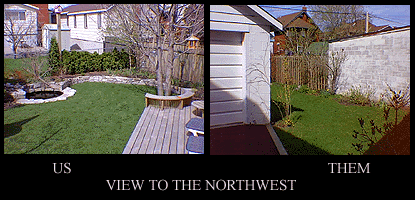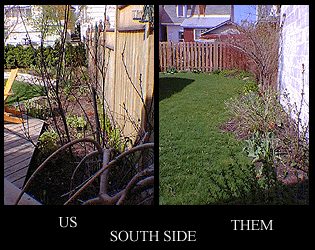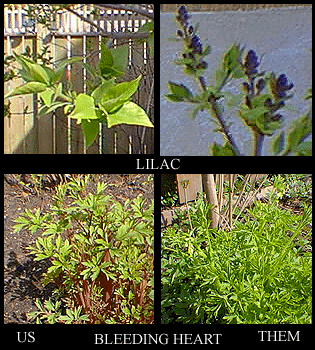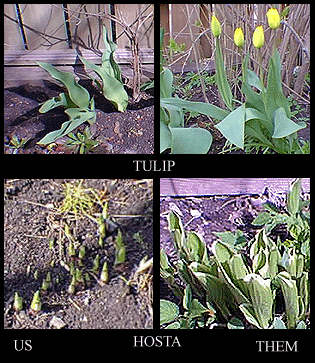The famous Ottawa Tulip
Festival opened a few days ago with cameramen swarming around the few brave tulips which had managed to open in spite of our slow, cold, wet spring. Our own garden seems two weeks (if not a month) behind its normal growth. And yet, 60 feet to the north of us, our neighbor's garden is flourishing. Microclimates, whether accidental or intended, can dramatically affect both the length and nature of your garden's growing season. For cold climate gardeners, the jump on spring and the longer fall are perhaps more dramatic (and useful) than the increased heat during the mid summer months.
|
Concrete ponds are problematic in areas with sustained periods of cold weather. Built correctly, they will most probably winter fairly well. There are, however, very few problems with liner ponds. We do take the precaution of lowering the water level by 10%, so the expanding ice will not damage any of the surrounding stonework, which is cemented together and therefore rigid.
|
|
Since we never really know how severe the winter will be, we
always turn off the underwater pump and drain the feeder lines
by blowing air through them. Check the storage conditions required
for your pump: some cannot dry out and must be stored in water;
some can be cleaned and dried and put on a shelf for the winter.
Ours does winter duty in our basement pond, but could be dried
out if required.
We are careful, however, to cut off the summer growth on our
water plants, and use netting and fairly constant skimming to
keep leaves out of the pond. Vegetable matter rots, and robs the
oxygen from the pond water. Even if you are not going to overwinter
fish, keep your pond clean. The smell next spring alone is worth
the effort! Believe me! A bit of precaution in the fall can help
you avoid a very unpleasant spring cleaning experience.
Our neighbor's good fortune is, for the most part, accidental.
Lots in this area are narrow (30 feet), and many retain their
original late forties necessity: the one car detached garage which
occupies at least 1/3 of the lot's width! Our neighbor's garden
is sandwiched between two staggered white-walled cement block
garages with the spaces between filled in with 8' high "ventilated"
wood fences and a short 15 foot high overgrown cedar hedge.
Their luck continued with the fact that prevailing winds were
dispersed rather than concentrated by the staggered and varied
wind blocks, and that the southern and especially western sides
were only partially blocked. The south facing side, in fact, receives
direct sunlight from about 10 am onward.
The creation of a warmer microclimate is a relatively simple
concept to effect. Through the use of structures (walls, fences,
etc) and plantings you diminish the prevailing
cold winds, while maximizing the amount of sunlight your garden
receives and the heat it retains. Simple, but
about as easy to predict as the weather! With the same techniques
you can create an airless hothouse and/or a wind tunnel.
A solid wall, be it constructed or grown, pushes the wind straight
up, over, and straight down creating a very windy area at the
base of a wall. A roofed structure pushes the air out at roughly
the pitch of the roof. Without an eaves trough, however, that
roof creates a drip line which also is not plant friendly. But,
the solid material of the structure, especially if it is cement,
stone, brick or some other heat retaining substance is the most
effective way to creating and retaining the extra heat which speeds
up spring and slows down fall.
On the other hand, a fence which allows air to penetrate through
it, or a hedge or tree blocks which are not very dense, slow down
and disperse the wind, and are therefore more effective at retaining
the heat generated within the garden without creating wind tunnel
effects. Of course, they are also considerable less effective
at retaining heat than the solid walled structures.
The goal in developing a warmer microclimate
is to create what our neighbor's have achieved by chance; that
is, a workable blend of south-facing structures which retain
|
|
 |
|
heat, with fences and hedges which disperseand slow down the winds,
and a garden as open as possible to all available sunlight. Go
at the project slowly. Over an extended period of time, record
accurately your prevailing winds (if you are not aware of them
already). Wander through your neighbors' gardens, especially in
early spring and late fall, looking for the placement of existing
structures and plantings, and how they are affecting growth. Remember
to take into account drainage as well. Raised beds and naturally
|
 |
|
Consider the
compromises and combinations which may be available to you. In
general, solid structures are quick and effective, but are expensive,
take up space and should have some other essential function. Heat-retaining
walls are quick, efficient but are expensive. Plant barriers are
less expensive, but slow to grow and potentially quite large space
users too.
|
 |
Useful combinations
might be relatively short stone or brick walls, backed by airy
plantings to disperse the wind; wide raised beds, backed by tall,
airy plantings, but leaving plenty of planting room in front;
combination fencing alternating heat-retaining and ventilating
areas; other combinations of fencing and plantings; deck, patio
and other horizontal garden structures constructed with heat retaining
materials; and structures which reflect light.
Creating a
cooler microclimate is not entirely the reverse.
While you do want to limit the amount of sunlight, you may still
want to retain substantial areas of full light for sun-loving
plants, and while you may want to ensure you do not block potentially
cooling breezes, you don't want to be in the middle of a wind
tunnel either! In fact many of the basic techniques are the same:
structures and vegetation which slow down, disperse and/or partially
block light and prevailing winds
|
 |
|
Is there a
convenient golden rule? Not really, but you can
get a very useful lesson from the environmental disasters high
rise city centers have created. Too much of any one thing spells
trouble; diversification is the key. One tall building does not
create a wind tunnel. A row of them does. One tall building does
not create a sunless cold environment. A row of them does. By
incorporating a variety of techniques, you may not get the perfect
environment a wind tunnel model may have helped you develop, but
you won't be in tears either!
|
|

